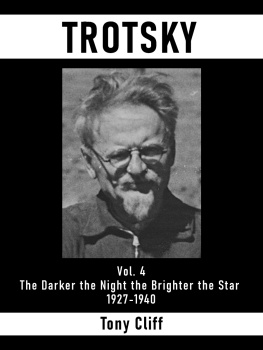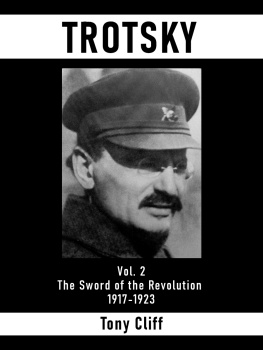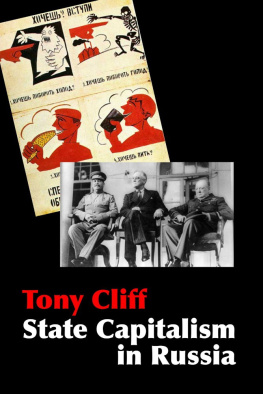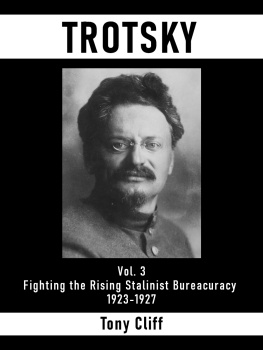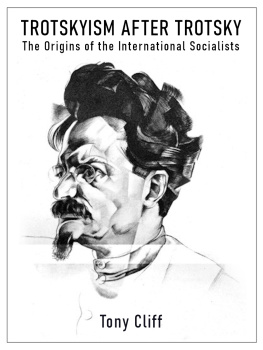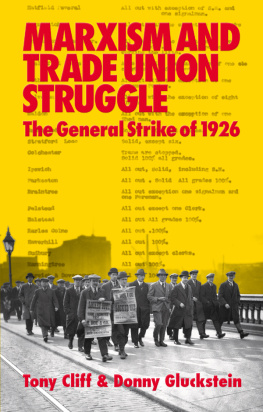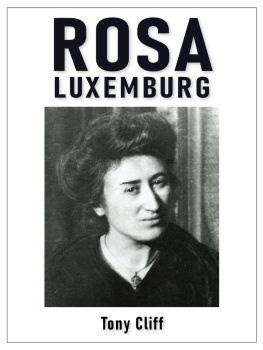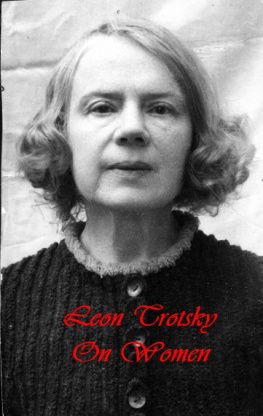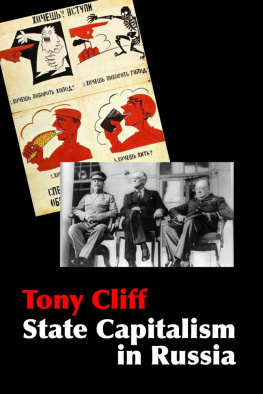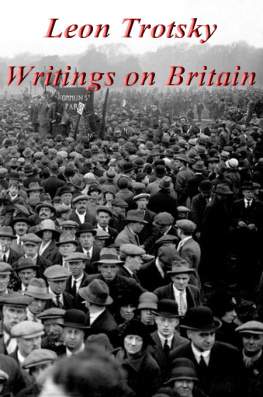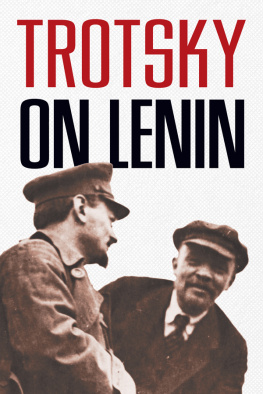Tony Cliff - Trotsky: Vol. 4. The Darker the Night the Brighter the Star 1927-1940
Here you can read online Tony Cliff - Trotsky: Vol. 4. The Darker the Night the Brighter the Star 1927-1940 full text of the book (entire story) in english for free. Download pdf and epub, get meaning, cover and reviews about this ebook. year: 2020, publisher: Marxists Internet Archive, genre: Politics. Description of the work, (preface) as well as reviews are available. Best literature library LitArk.com created for fans of good reading and offers a wide selection of genres:
Romance novel
Science fiction
Adventure
Detective
Science
History
Home and family
Prose
Art
Politics
Computer
Non-fiction
Religion
Business
Children
Humor
Choose a favorite category and find really read worthwhile books. Enjoy immersion in the world of imagination, feel the emotions of the characters or learn something new for yourself, make an fascinating discovery.
- Book:Trotsky: Vol. 4. The Darker the Night the Brighter the Star 1927-1940
- Author:
- Publisher:Marxists Internet Archive
- Genre:
- Year:2020
- Rating:4 / 5
- Favourites:Add to favourites
- Your mark:
- 80
- 1
- 2
- 3
- 4
- 5
Trotsky: Vol. 4. The Darker the Night the Brighter the Star 1927-1940: summary, description and annotation
We offer to read an annotation, description, summary or preface (depends on what the author of the book "Trotsky: Vol. 4. The Darker the Night the Brighter the Star 1927-1940" wrote himself). If you haven't found the necessary information about the book — write in the comments, we will try to find it.
Trotsky: Vol. 4. The Darker the Night the Brighter the Star 1927-1940 — read online for free the complete book (whole text) full work
Below is the text of the book, divided by pages. System saving the place of the last page read, allows you to conveniently read the book "Trotsky: Vol. 4. The Darker the Night the Brighter the Star 1927-1940" online for free, without having to search again every time where you left off. Put a bookmark, and you can go to the page where you finished reading at any time.
Font size:
Interval:
Bookmark:
1927-1940
Bookmarks, London, 1993.
Transcribed by Martin Fahlgren (July 2009)
Marked up by Einde OCallaghan for the Marxists Internet Archive
Converted to ebook format June 2020
Cover photograph: Trotsky, from a photo with American Trotskyites Harry De Boer, James H. Bartlett and their spouses, April 5, 1940
Wikimedia Commons
At the time of ebook conversion this title was out of print.
Other works of Tony Cliff are available in hardcopy from:
https://bookmarksbookshop.co.uk/
Several people have helped in the writing of this book. A number of them helped in locating material: Panos Garganas, Volkhard Mosler, John Mullen, Jean Peltier, Knut Sand and Ahmed Shawki. A number of comrades translated various texts: Ersy Contogouris, Elana Dallas, Gareth Jenkins, Jake Hoban, Einde OCallaghan and Mary Phillips. Many thanks are due to Chris Bambery, Alex Callinicos, Lindsey German, Chris Harman and John Rees for their advice and suggestions. Chanie Rosenberg deserves a special thanks for participating in the editing of the manuscript and for typing it. Thanks are due to John Molyneux and Donny Gluckstein for expert critical comments and most valuable stylistic suggestions, and Duncan Blackie for editing the book.
Tony Cliff
April 1993
THE PRESENT volume, the last in this political biography of Trotsky, covers the period between his banishment to Alma Ata, the capital of Kazakhstan on 17 January 1928, and his assassination in Mexico on 20 August 1940. This period was the most tragic of his eventful, stormy life. It was a period of some thirteen years of deep darkness unbroken by a single shaft of light.
When Trotsky stated in 1927 that the vengeance of history is more powerful than the vengeance of the most powerful General Secretary, he could not have had an inkling of the horrors this General Secretary would inflict on himself and his family.
First Zina, his eldest daughter: she had tuberculosis, and had been given permission by the Soviet government to go to Germany for treatment. One of her two sons, Seva, was allowed to go with her, while another, a daughter of six or seven years, was kept as a hostage by Stalin. Her husband, Platon Volkov, was deported to a labour camp in Siberia. The death of her sister Nina, the persecution of her father, the deportation of her husband, and the difficulty of keeping herself and her two children alive, strained her mental balance. After undergoing several operations on her lungs, she had to be treated by psychologists. Her doctor reached the conclusion that to recover she should rejoin her family in Russia. But Stalins spite knew no bounds: she and Seva were deprived of Soviet citizenship. In desperation Zina committed suicide on 5 January 1933. She was 30 years old. Six days after Zinas death Trotsky wrote an Open Letter to the leadership of the Soviet Communist Party and government: Zina was too sick to be able to be active politically, and it was simply venomous cruelty that deprived her of Soviet citizenship and finally broke her spirit. She did not choose that of her own will. She was driven to it by Stalin.
Zinas sister, Nina, had died live years earlier, on 9 January 1928. Ninas husband, Man-Nevelson, was arrested and sent to a labour camp in Siberia. Nina, who was very active in the Opposition, was expelled from the party and kept from all work. Laid low by illness, she died of tuberculosis a few weeks later. She was 26 years old. The letter she wrote to her father from the hospital took 73 days to reach him, arriving after she died. She left two children who were cared for, together with Zinas daughter, by her mother, Alexandra Sokolovskaia, Trotskys first wife.
The third of Trotskys children was Leon Sedov, Lyova. He accompanied his father to banishment in Alma Ata, and then to exile in Turkey. He was forced to leave his wife and child behind. Leon Sedov was Trotskys right-hand man in the leadership of the Opposition. At the beginning of February 1938 he fell sick and went into a small private clinic run by some Russian migr doctors in Paris. There the hand of the GPU caught up with him. He was poisoned and died on 16 February 1938, at the age of 32.
Trotskys youngest child was Sergei. He was a scientist, a professor in the Institute of Technology, who shunned politics. Hence he did not wish to join his father in banishment or exile and he avoided all contact with his father. But Genghiz Khan with a telephone did not spare him. In December 1934 he was imprisoned and then exiled to Vorkuta labour camp. The last news of him came in 1936 when he joined a hunger strike of Trotskyists in all the Pechora camps, which lasted 132 days.
Finally, Alexandra Sokolovskaia: she was an active Oppositionist who had to take care of three of Trotskys grandchildren. In 1936 she was expelled from Leningrad, first to Tobolsk, and then to a remote settlement in Omsk Province. The grandchildren were given to an old aunt to look after, and were at fates mercy. She was shot in 1938, like all Trotskys four children the victims of Stalin.
Rosa Luxemburg and Karl Liebknecht were murdered, and the working class movement has many, many other martyrs. But Trotskys position is unique. He was murdered not once, but again and again. His suffering and courage were unequalled. Prometheus was chained to a rock and the eagle picked into his liver but he never yielded or had any doubt about his stand. On 4 April 1935 Trotsky wrote in his diary: [Stalin] is clever enough to realise that even today I would not change places with him.
Nothing relieved the agony, but still there was no self-pity, no pettiness; only a combination of clarity of thinking, passion and indomitable will.
Stalins revenge on Trotskys supporters was also terrible. In 1927-8, the mass of workers in Russia were depressed by the isolation of the Soviet Union as a result of the defeat of international revolutions, from Germany to China. Still the Trotskyists had an impressive influence among hundreds of thousands of Russian workers. Heightened Opposition activity was reported from all over the USSR. In widespread industrial disputes it played a very significant role. The number of Trotskyists in prison and places of exile was very large indeed, estimated at 8-10,000.
But the years 1928-9 saw the collapse of the Left Opposition in the USSR. Two forces squeezed it. First, there was a decline in the struggle and consciousness of the working class. As a result of the massive industrialisation under the Five-Year Plan the composition of the proletariat changed radically. The old, experienced proletariat formed under Tsarism, found itself swamped by millions of new workers, largely ex-peasants, who had no tradition of industrial life, no tradition of solidarity, no class consciousness. The proletariat was now completely atomised.
The same process that led to the atomisation of the industrial proletariat, led also to a devastating ideological crisis in the Left Opposition. Trotsky and the Left Opposition had for years called Stalin a Centrist arguing, quite rightly at the time that he and his bureaucracy vacillated between the proletariat on the one hand and the kulaks and NEPmen on the other. Trotsky assumed that Stalin could never take an independent position, that he was bound to fall as a result of the victory of one of the two basic forces. He thought that, in the final analysis, the fate of Soviet society would be decided by the struggle of the working class against the kulaks and NEPmen, while the bureaucracy would play only a secondary, mediating role. In fact the mutual paralysis of all social forces enabled Stalins bureaucracy to pragmatically muddle through the economic and social crisis. Using brute force Stalin imposed a series of
Font size:
Interval:
Bookmark:
Similar books «Trotsky: Vol. 4. The Darker the Night the Brighter the Star 1927-1940»
Look at similar books to Trotsky: Vol. 4. The Darker the Night the Brighter the Star 1927-1940. We have selected literature similar in name and meaning in the hope of providing readers with more options to find new, interesting, not yet read works.
Discussion, reviews of the book Trotsky: Vol. 4. The Darker the Night the Brighter the Star 1927-1940 and just readers' own opinions. Leave your comments, write what you think about the work, its meaning or the main characters. Specify what exactly you liked and what you didn't like, and why you think so.

